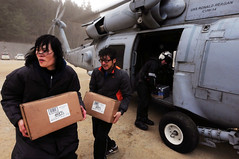Disaster relief donations: Stretching your donation dollar

Japanese citizens move food and water out of an HH-60H Sea Hawk helicopter assigned to the Black Knights of Helicopter Anti-Submarine Squadron (HS) 4. Ships and aircraft from the Ronald Reagan Carrier Strike Group are conducting search and rescue operations and resupply missions throughout northern Japan. (U.S. Navy photo by Mass Communication Specialist 3rd Class Alexander Tidd)
Donations toward disaster relief following the earthquake and tsunami in Japan are much lower so far than they have been for recent, comparable catastrophes like the earthquake in Haiti and Hurricane Katrina. According to CNN, four-day donation totals for Japanese relief are approximately $25 million, compared to $150 million for Haiti and $108 for Hurricane Katrina.
Several explanations have been offered for this, including so-called “disaster fatigue,” where people who would ordinarily give feel tapped out from all of the major disasters that have happened around the world in the last few years. The CNN article also provides other hypotheses for lower giving levels such as lower per-person giving due to text-message donations (people who donate $10 by text may feel their duty is done and are less likely to donate more), the perception that Japan doesn’t need as much help because it is a much wealthier country than Haiti, and the possibility that relief organizations are waiting to learn exactly what sort of relief is needed and where before making a big push for donations.
Lower donation totals are likely a result of a combination of these things and of another sentiment that I have seen among many people lately: they are afraid that their donation will not go where they think it’s going, or that only a portion of it will be used for actual relief efforts. Following Katrina and the Haiti earthquake, several news stories surfaced indicating that much of the money donated to several well-known and reputable relief organizations never made it to the people who needed help. The reasons for this are largely related to organizational factors, including the fact that many large relief organizations (such as a really popular one that uses a rouge plus sign as its emblem) employ a lot of people and have massive bureaucracies that tie up and absorb a lot of resources for a relatively long time. Donating to smaller, yet still reputable and established, relief organizations that have less overhead is one way to ensure that each dollar (or other monetary unit) of your contribution goes as far as it possibly can. A list of some of these organizations can be found after the jump.
- Direct Relief International
- Global Giving
- AmeriCares
- Operation USA
- Doctors Without Borders
- International Medical Corps
Many of these charities will allow you to specify where your donation will go, but a few of them place all donations into a general fund, to be directed where it is needed the most. Additionally, for those of you to whom it really matters, all of the charities I’ve listed are secular in nature, as while there are some exceptions, many religious charities tend to both have a lot of overhead and tend put some of their funds toward non-relief activities. It is primarily for these reasons that I do not recommend any religiously-affiliated charities.
Both the Japanese government and most international relief organizations have requested that people donate money rather than try to travel to Japan to help more directly. That said, if you do not currently have the financial resources to donate or donate as much as you’d like, you can act more directly by seeing if any relief organizations have offices in your area where you can volunteer your time, either helping to field donations or to take pressure off of other volunteers or employees at what is likely to be a busy time. Likewise, you can make people who are otherwise wary of donating money aware of the alternatives to the more highly-publicized relief campaigns such as the ones I’ve listed here.

